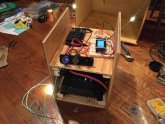Ok, it pulled 51 Amps, but from a battle born which as no voltage sag, the lead acid starting battery will sag, and will rapidly get under 12.7V especially just after engine starting not being sucked off see at 4:10 the charge will resume from 13.2V. In the test he says that the charger senses voltage, but later, says to connect the bvs to the battery for better sensing, also at the beginning when the 2 batteries were close in volts, the pull was around 30 amps. Then he discharged deeply the house battery to get the max amp, it's true that we saw 51 amps, but those conditions would almost never occurre in normal use, with bvs connected an lead acid as source battery.
(So Miles, if you forget to cut off the house loads, and you deeply discharge the house battery, you should be careful. If it's night check the starting battery voltage, drive for 2 hours at high RPM without the house battery connected to charge the starting battery :D :D :D Then reconnect and drive again for hours hehehe, it could do the trick, but man, i wouldn't do that.)
Seriously I think as you sayed before, if there is volts in pv in the amp draw will be max 25 amps and it should be ok. Even if there's no solar imput the charger will sense the voltage drop and not kill the alternator. Maybe but I know joey wants to kill it. Let's ask will to do the test on a real car.








